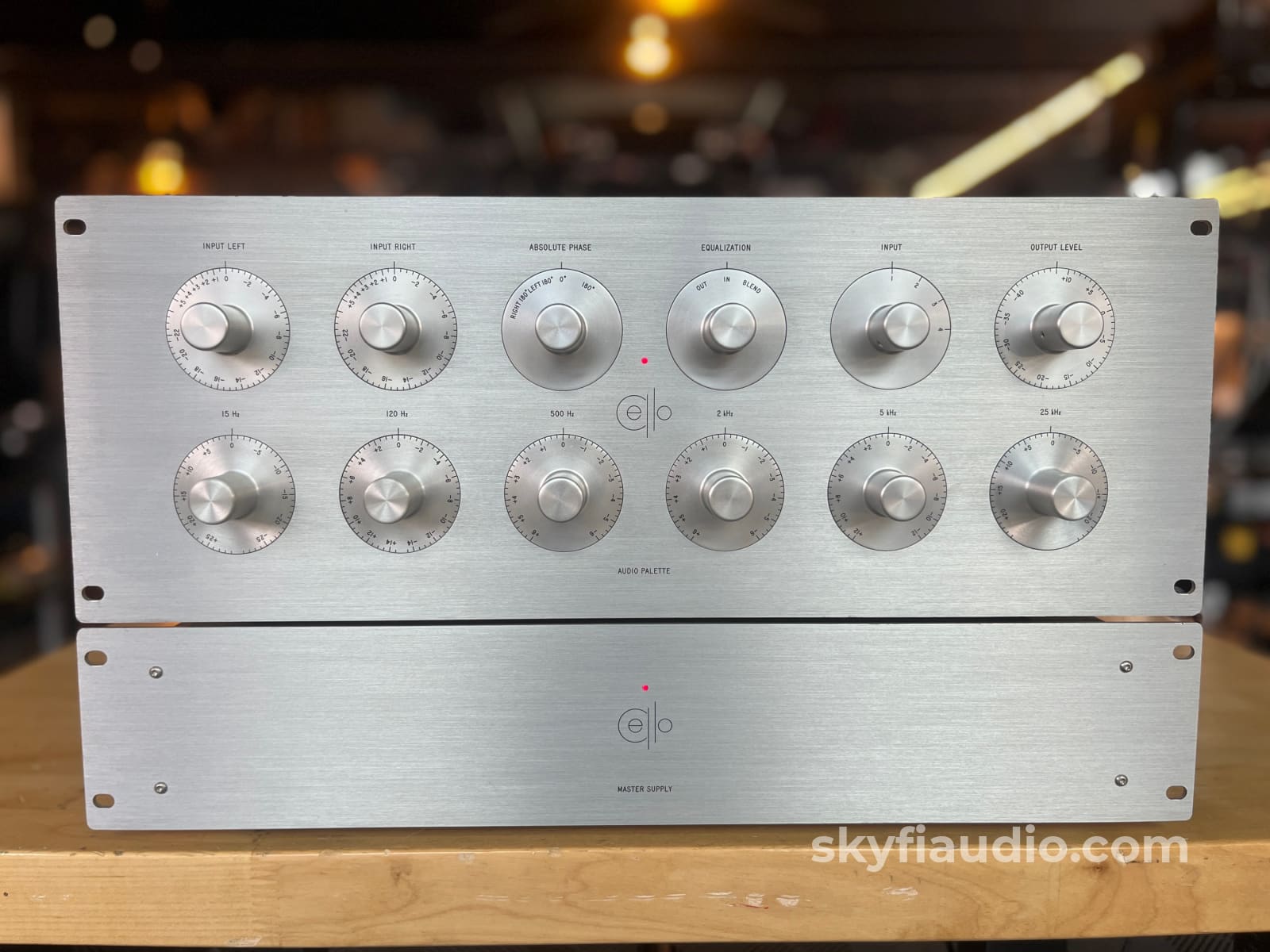
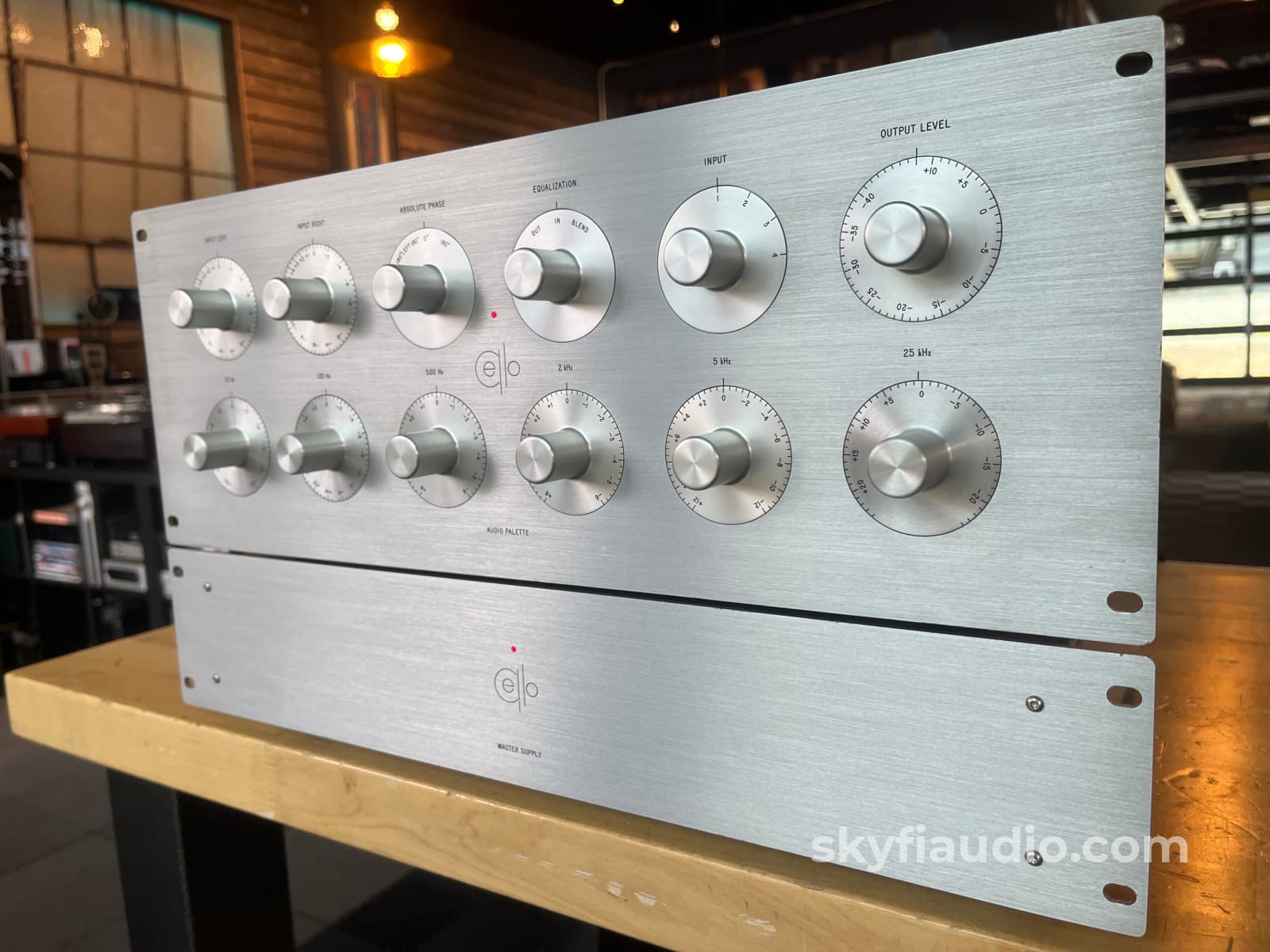
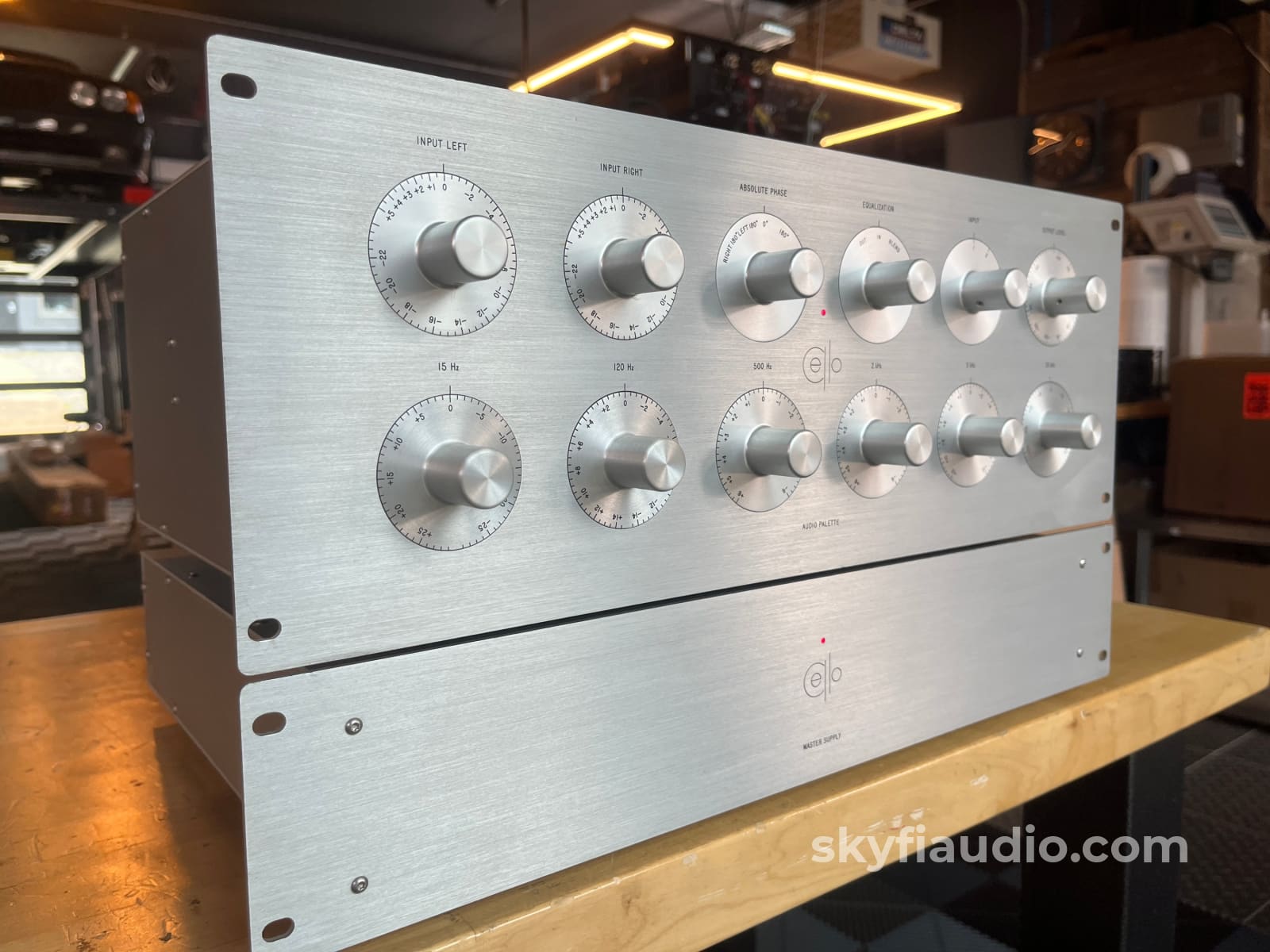
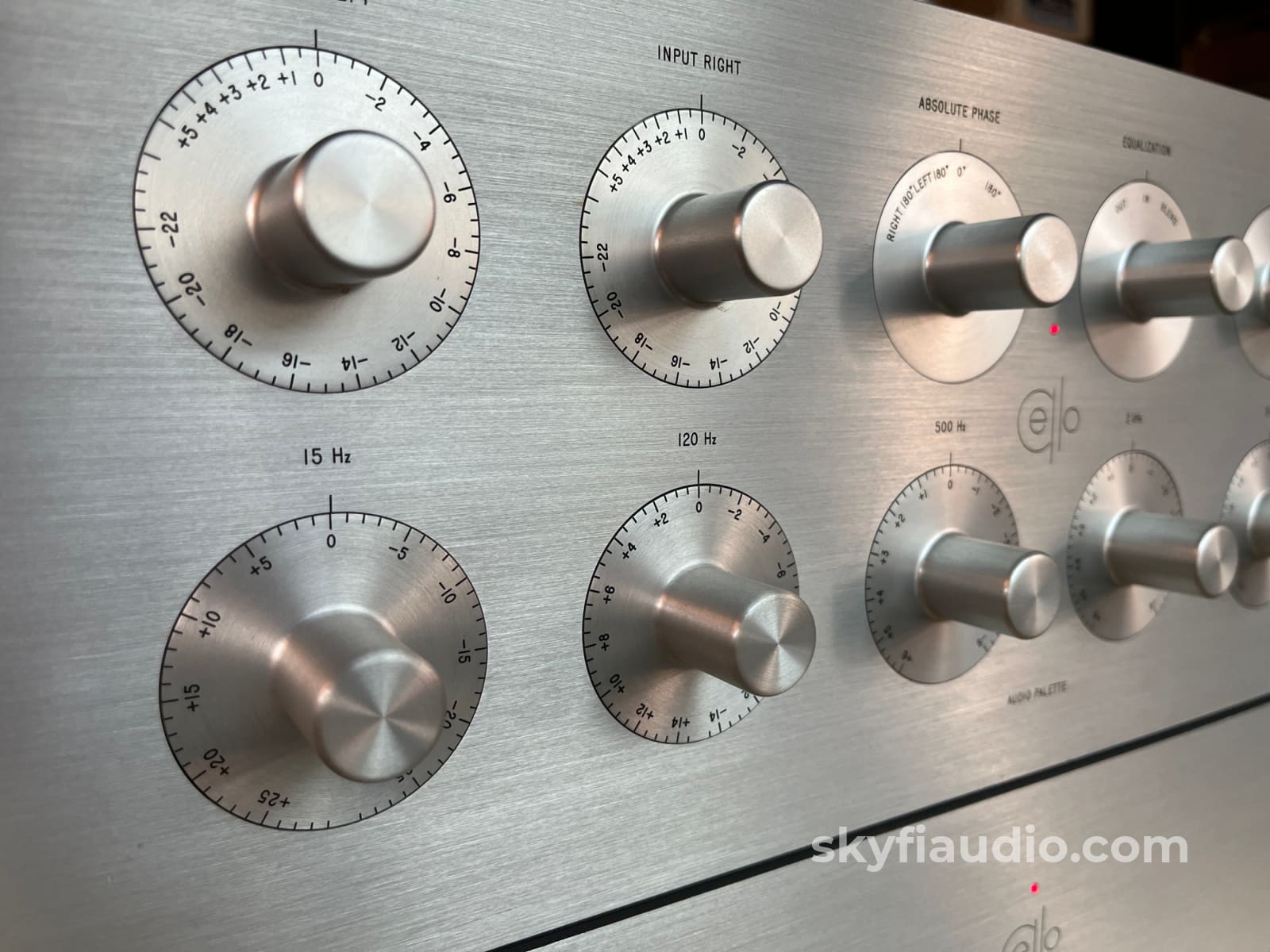
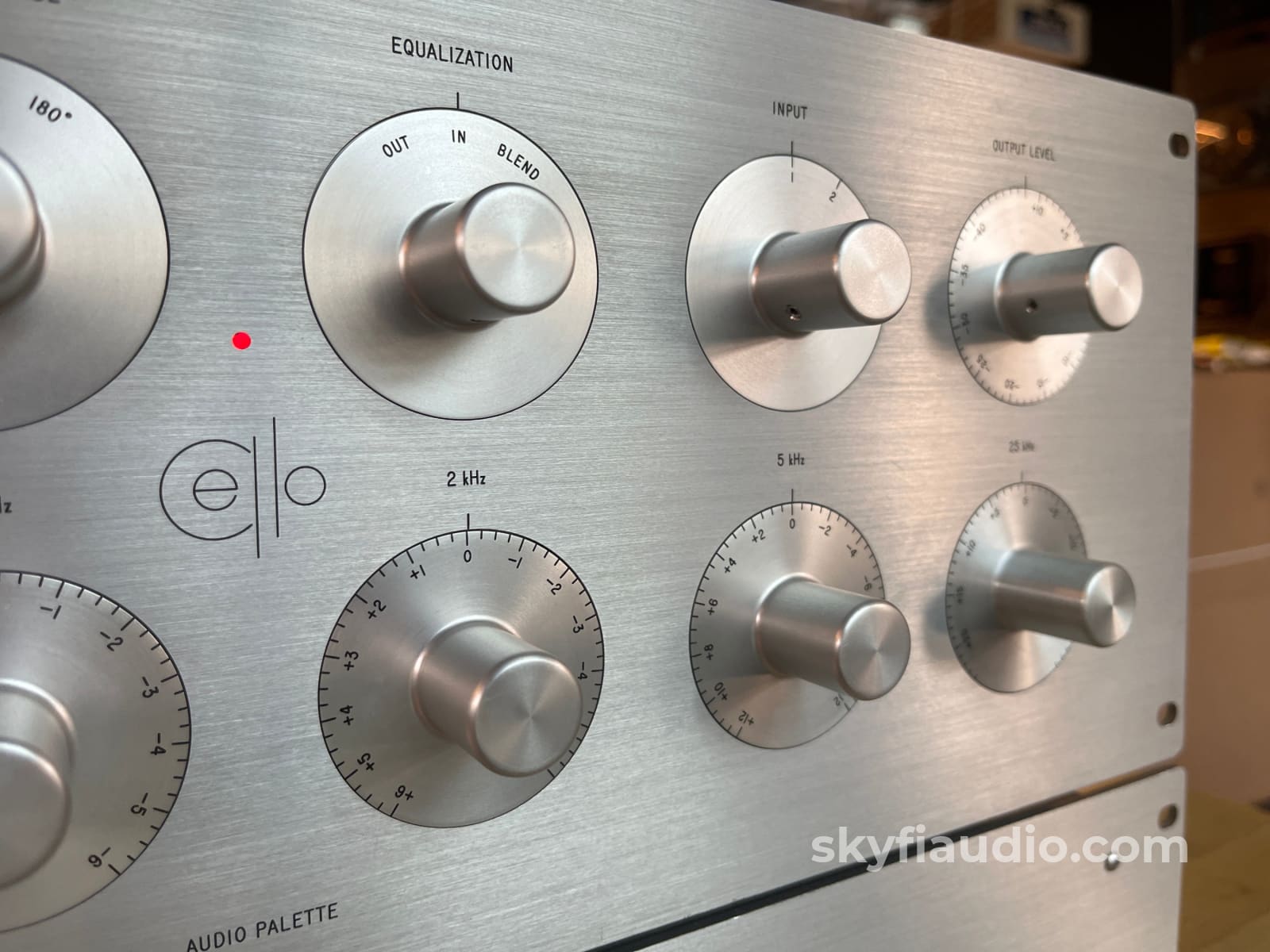
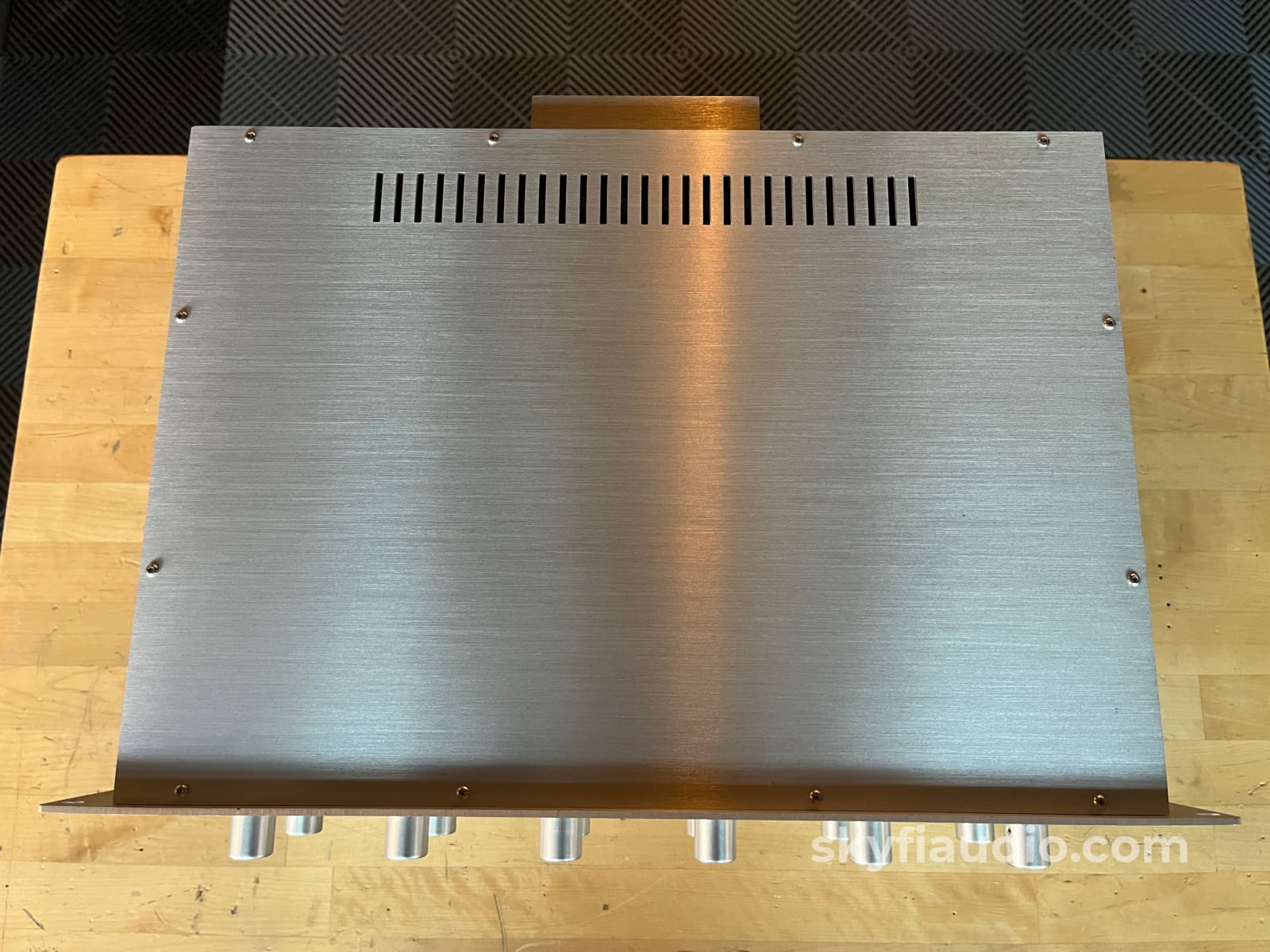
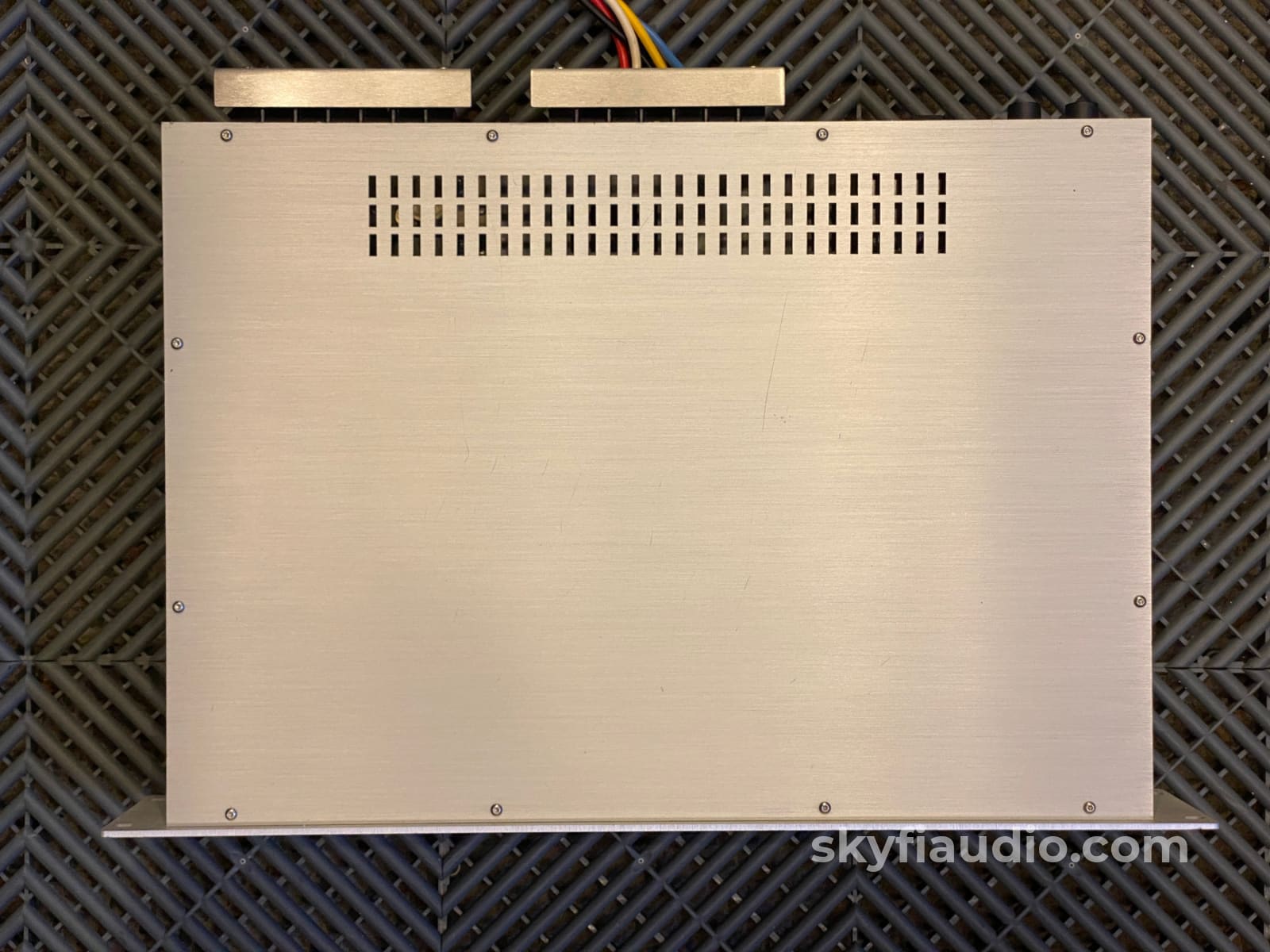
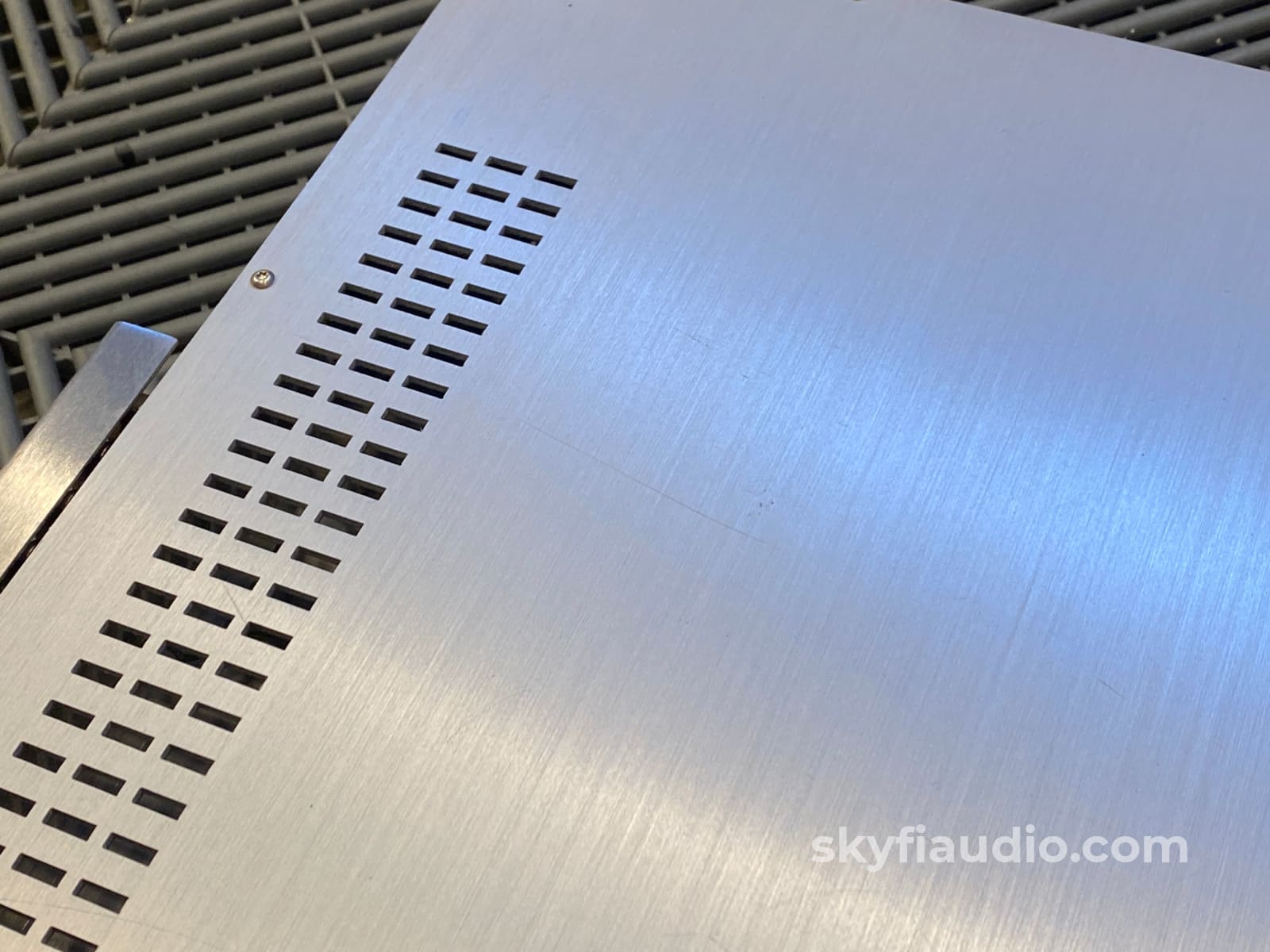
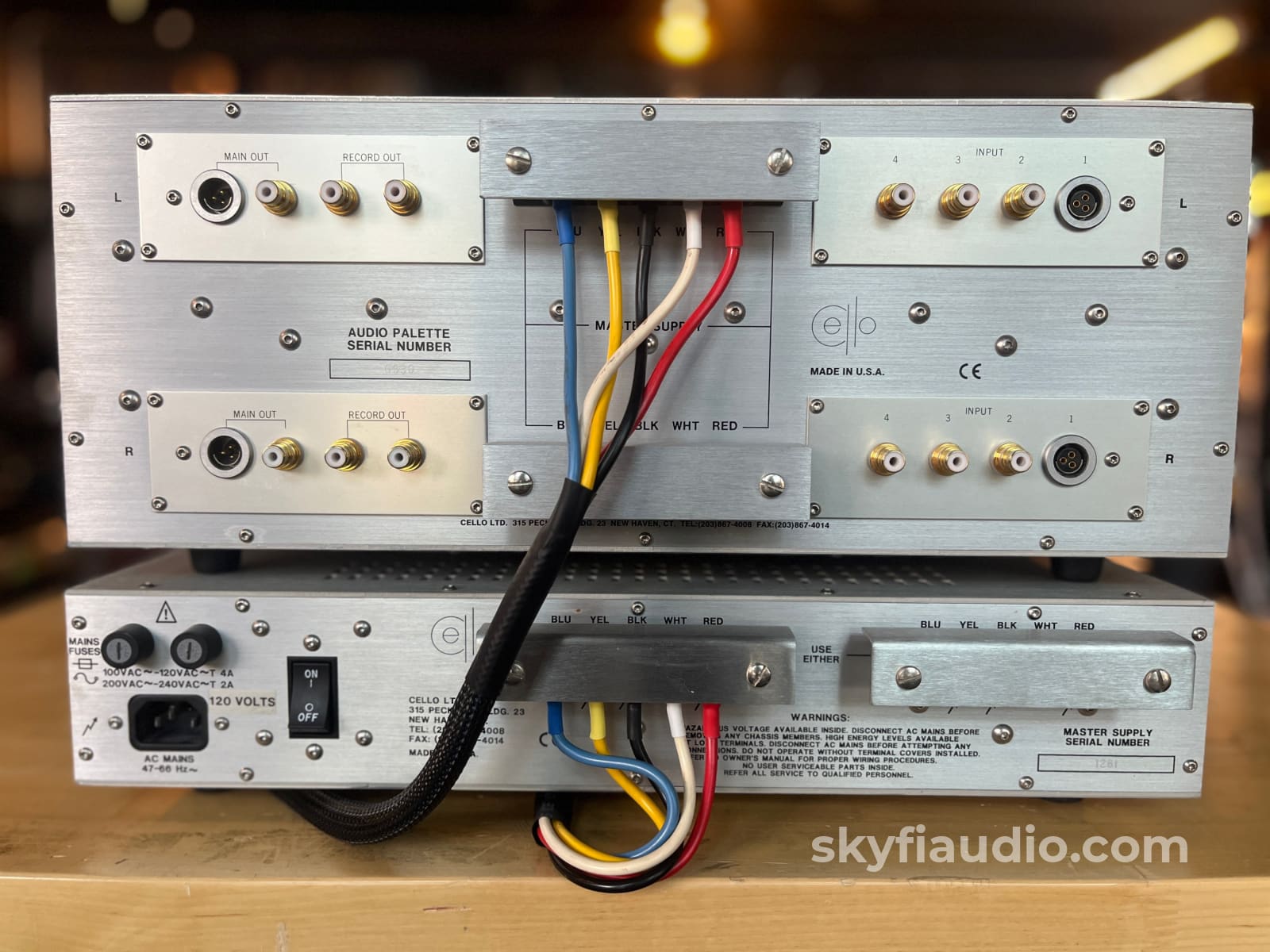
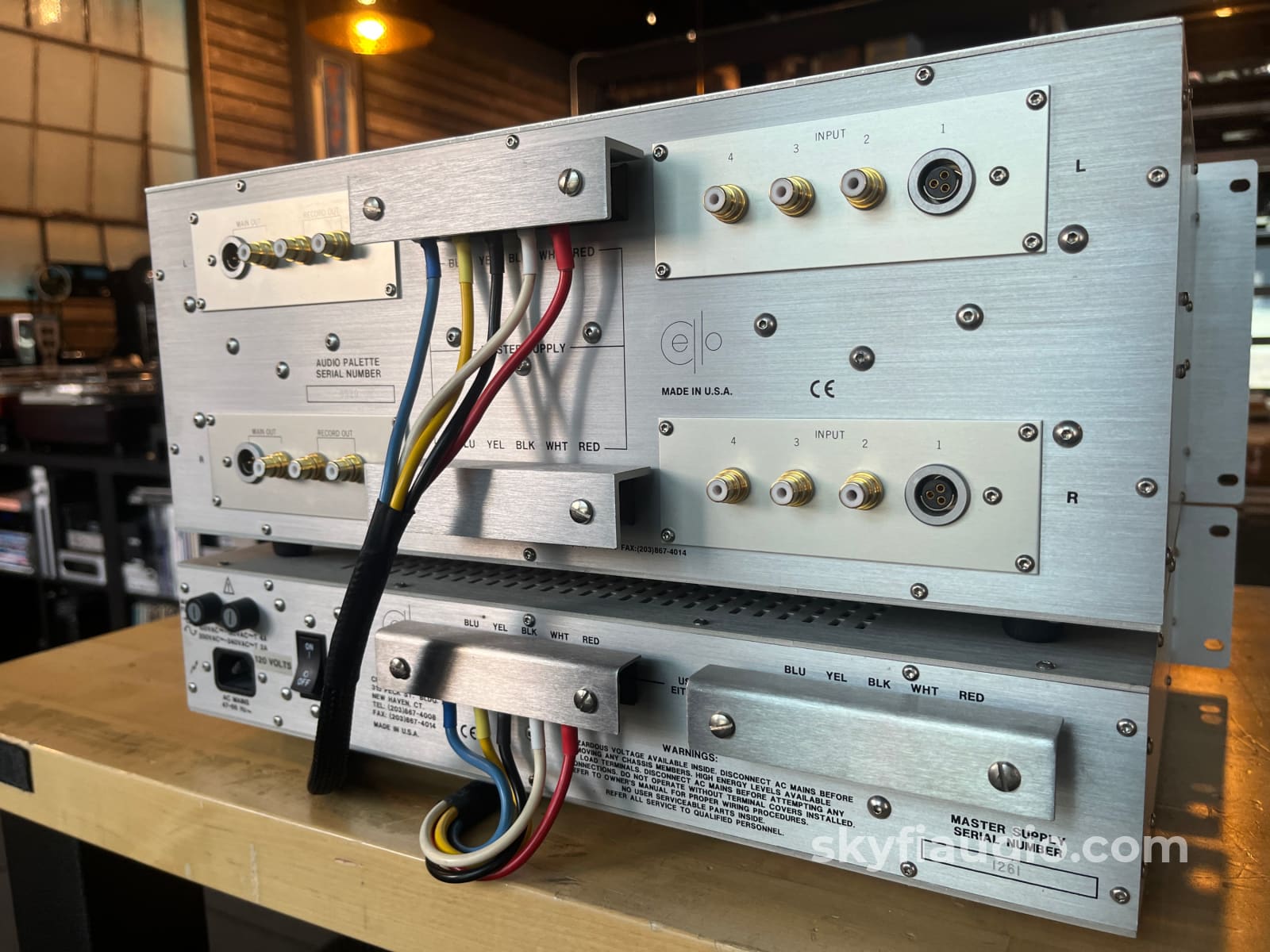
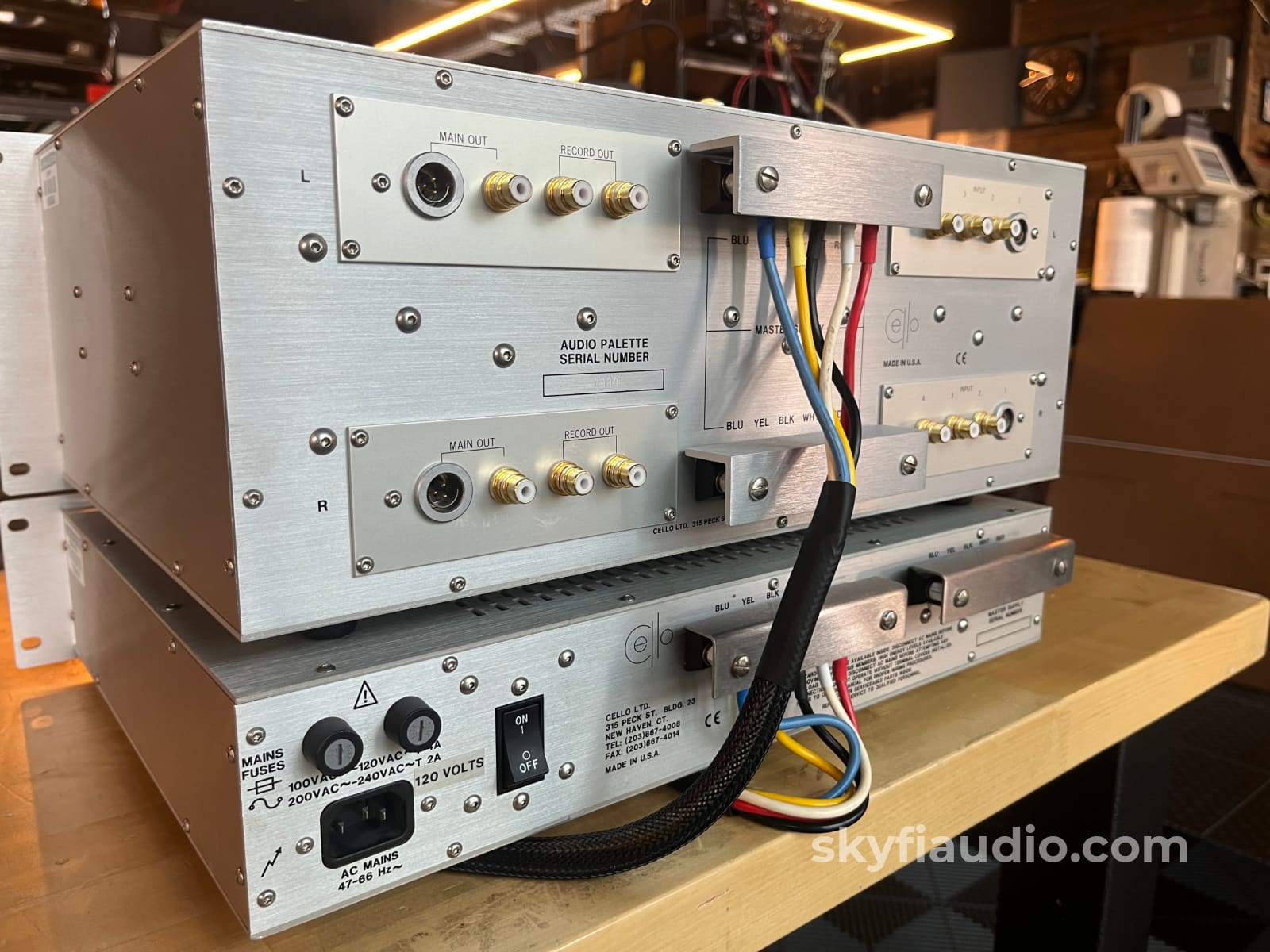
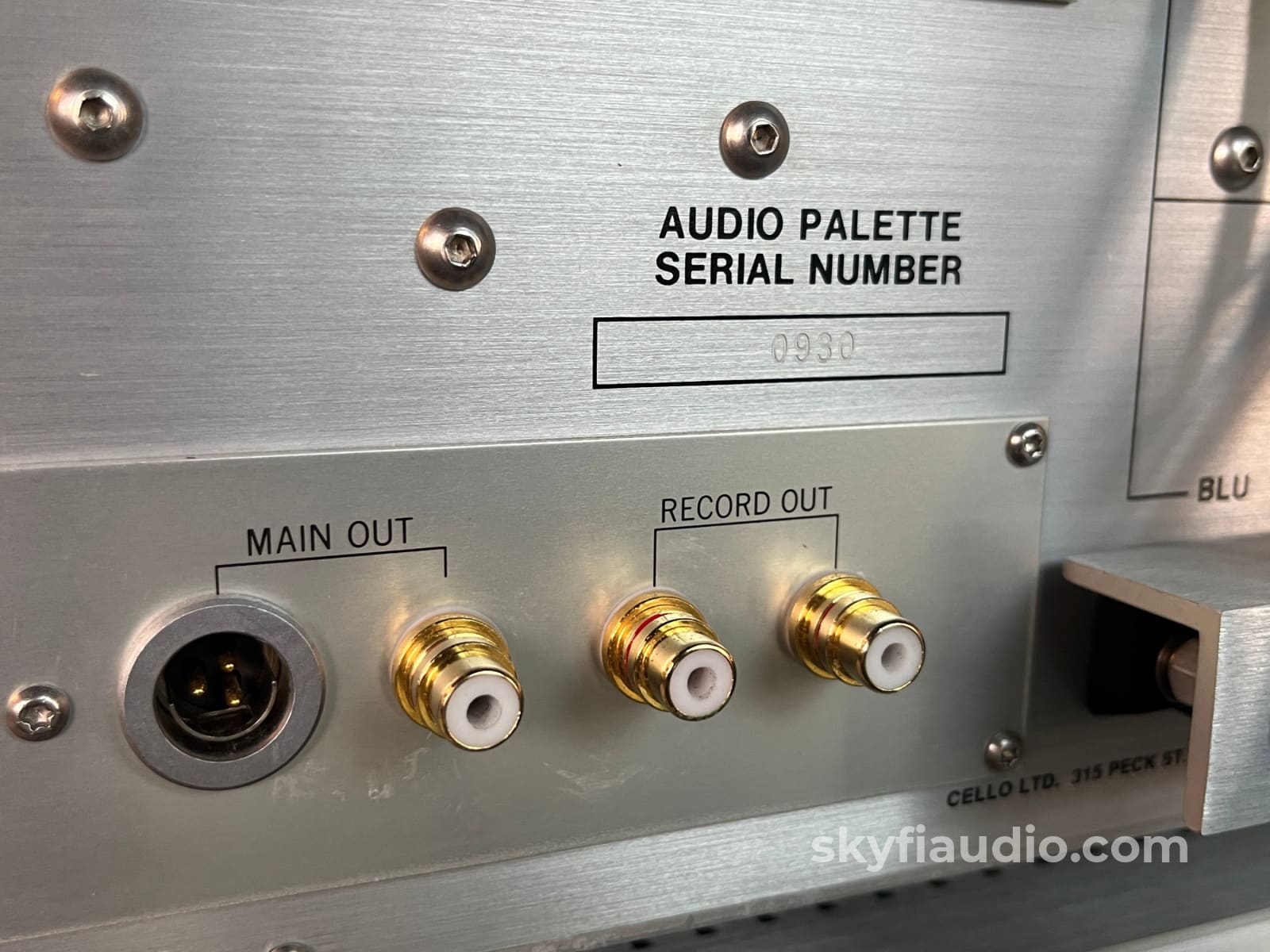
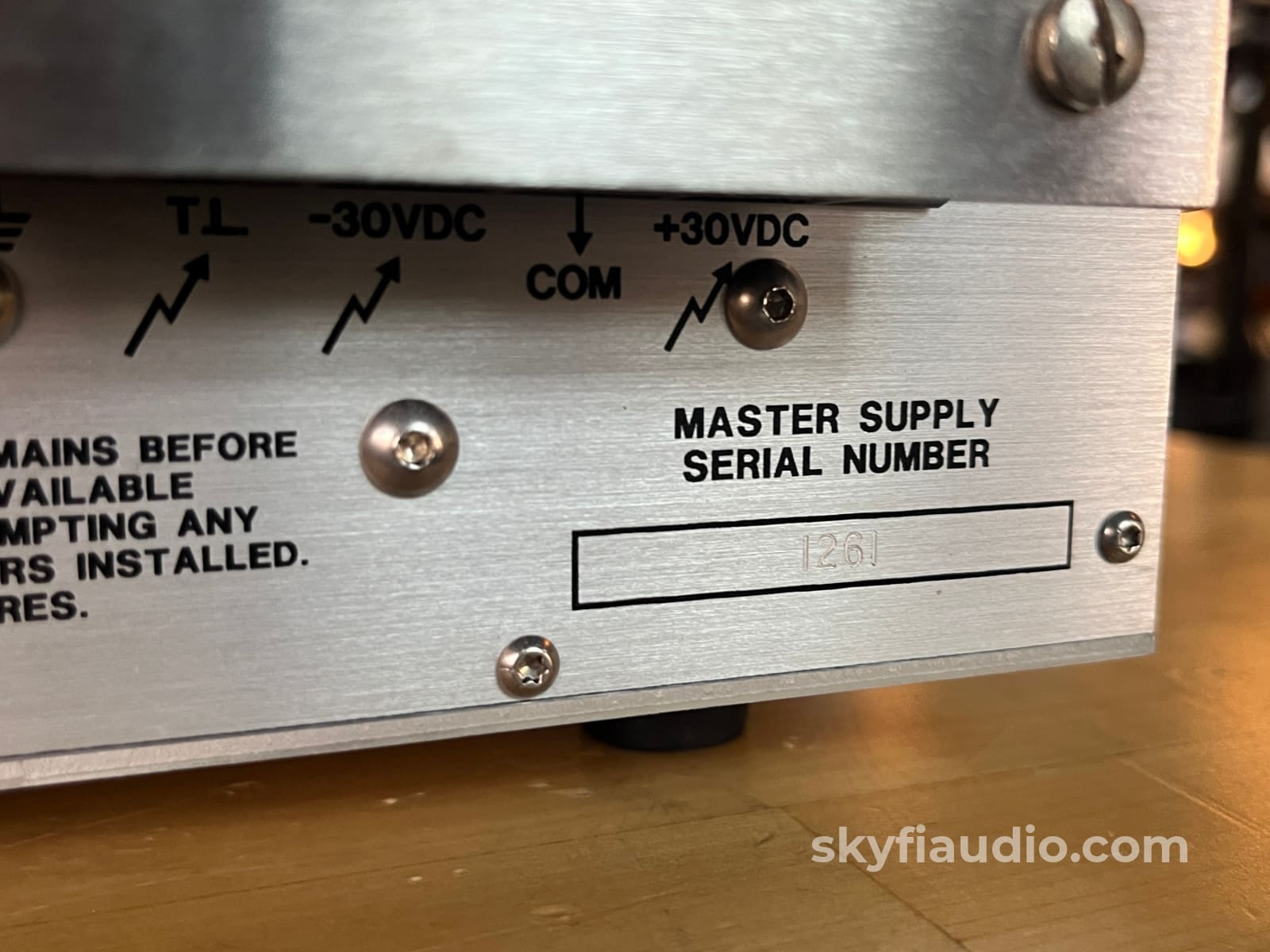
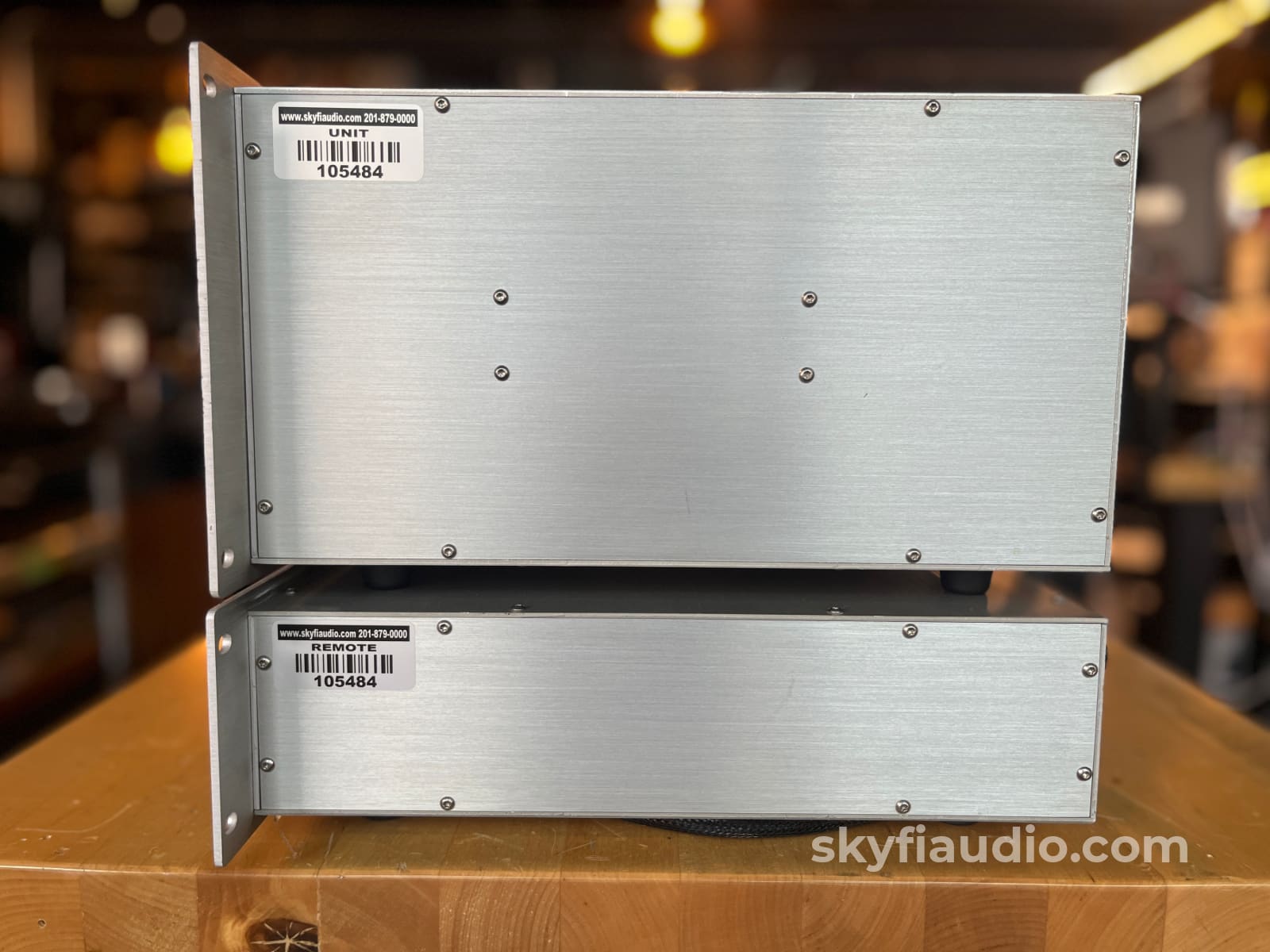
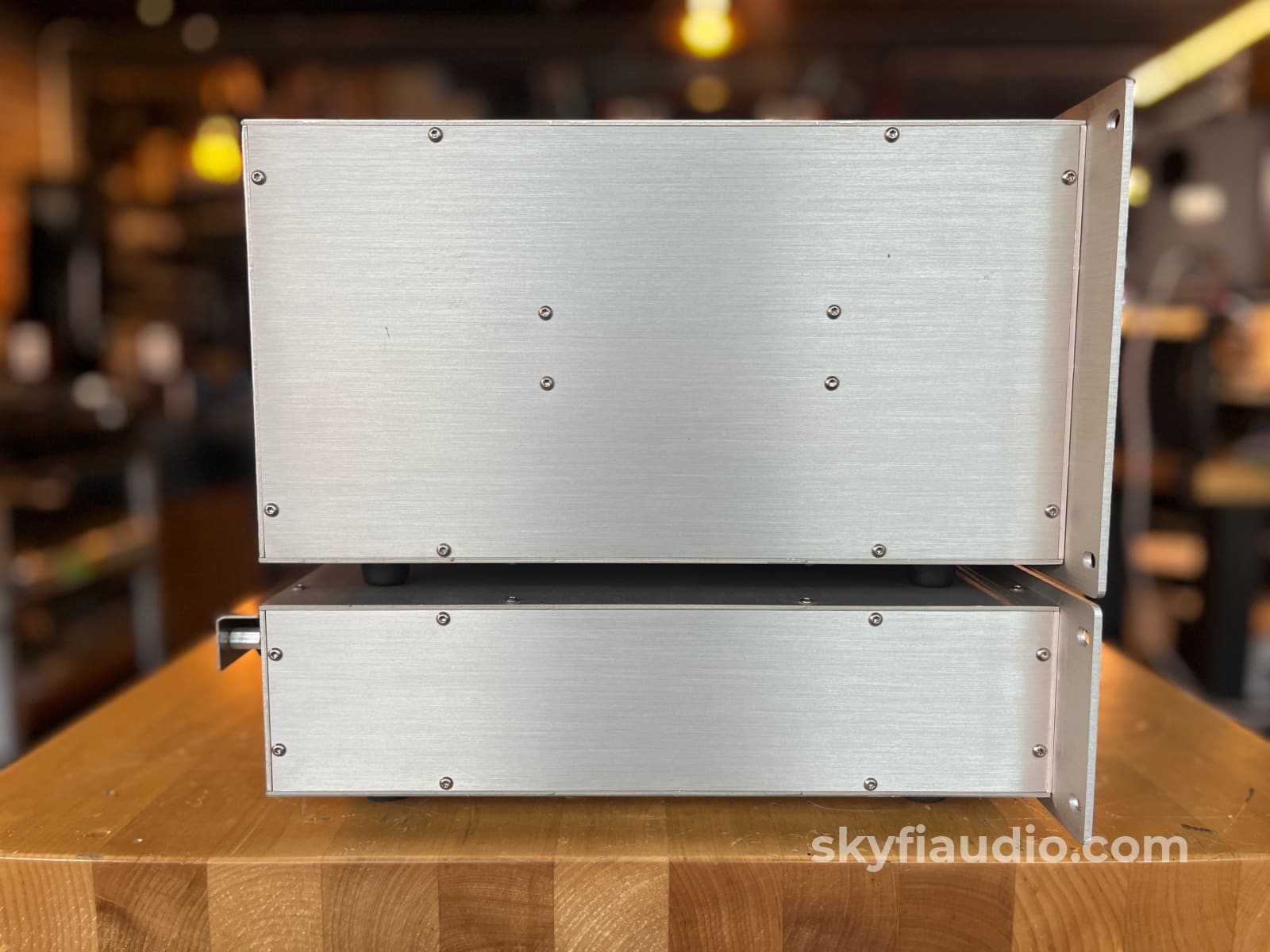
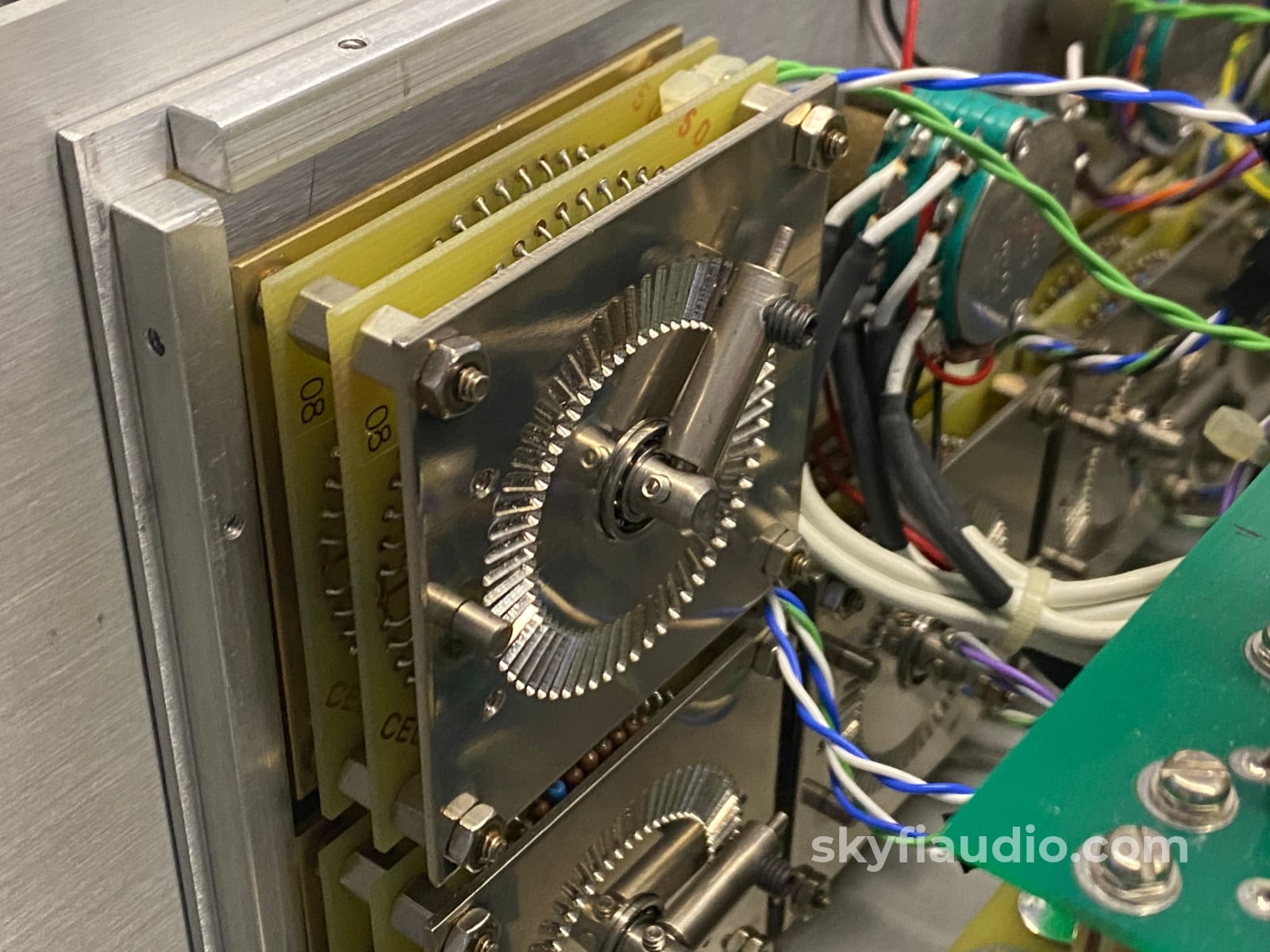
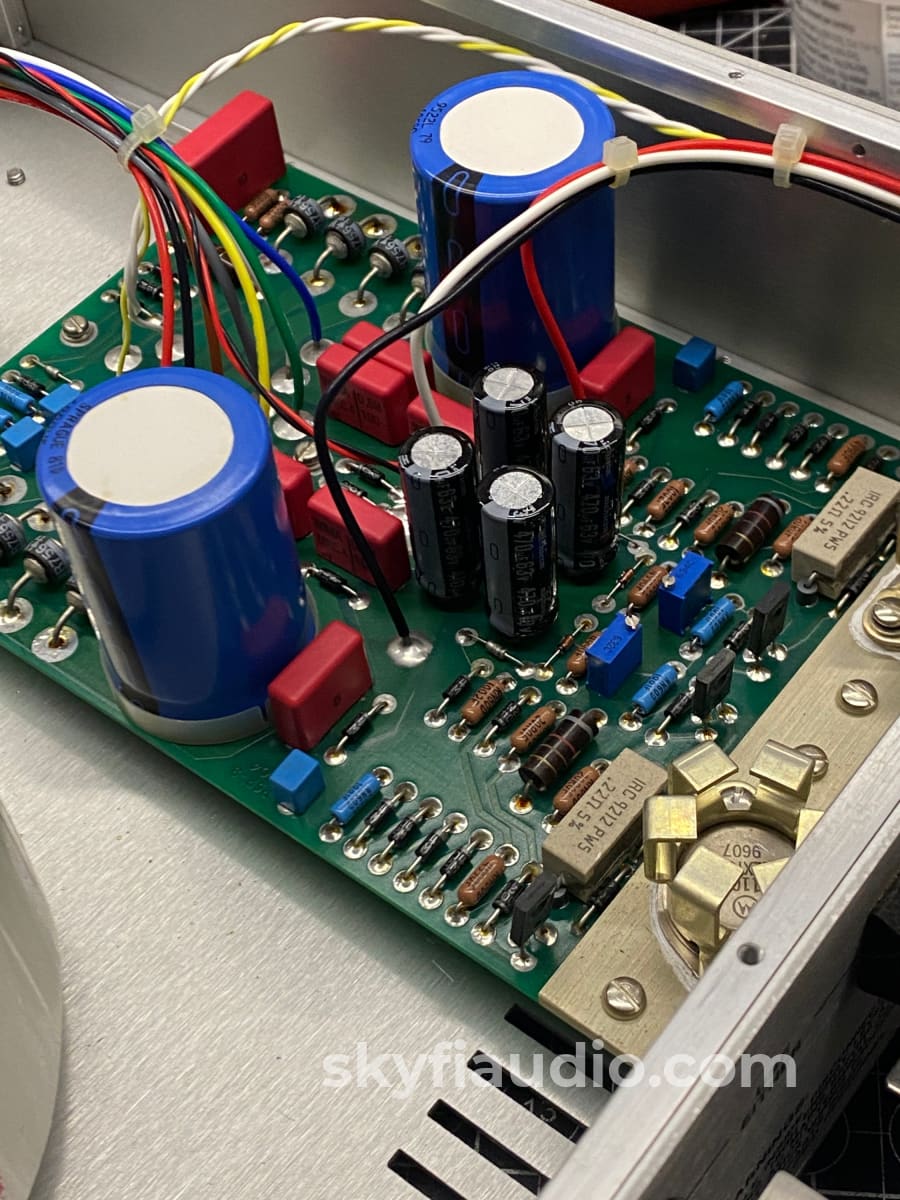
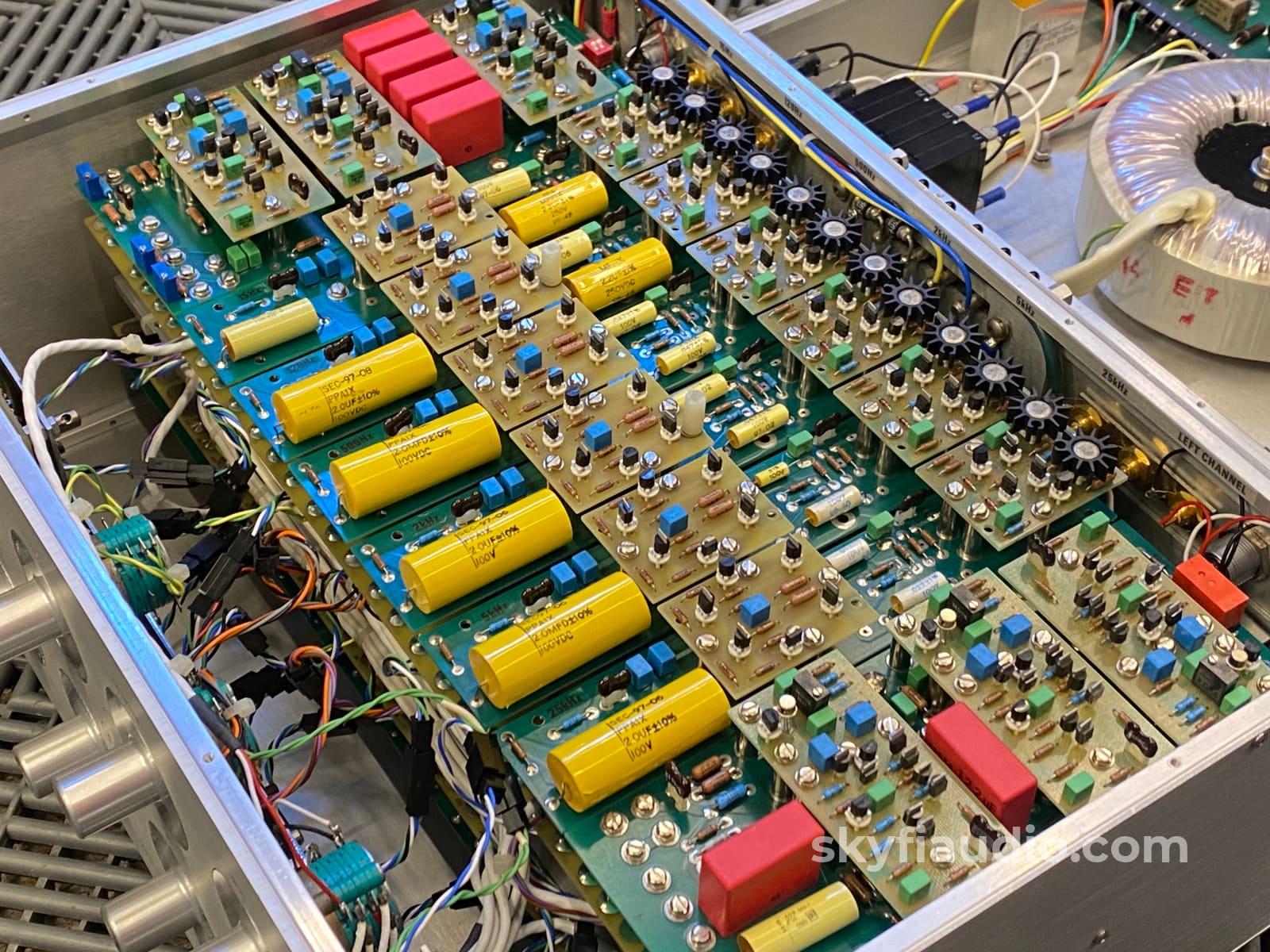
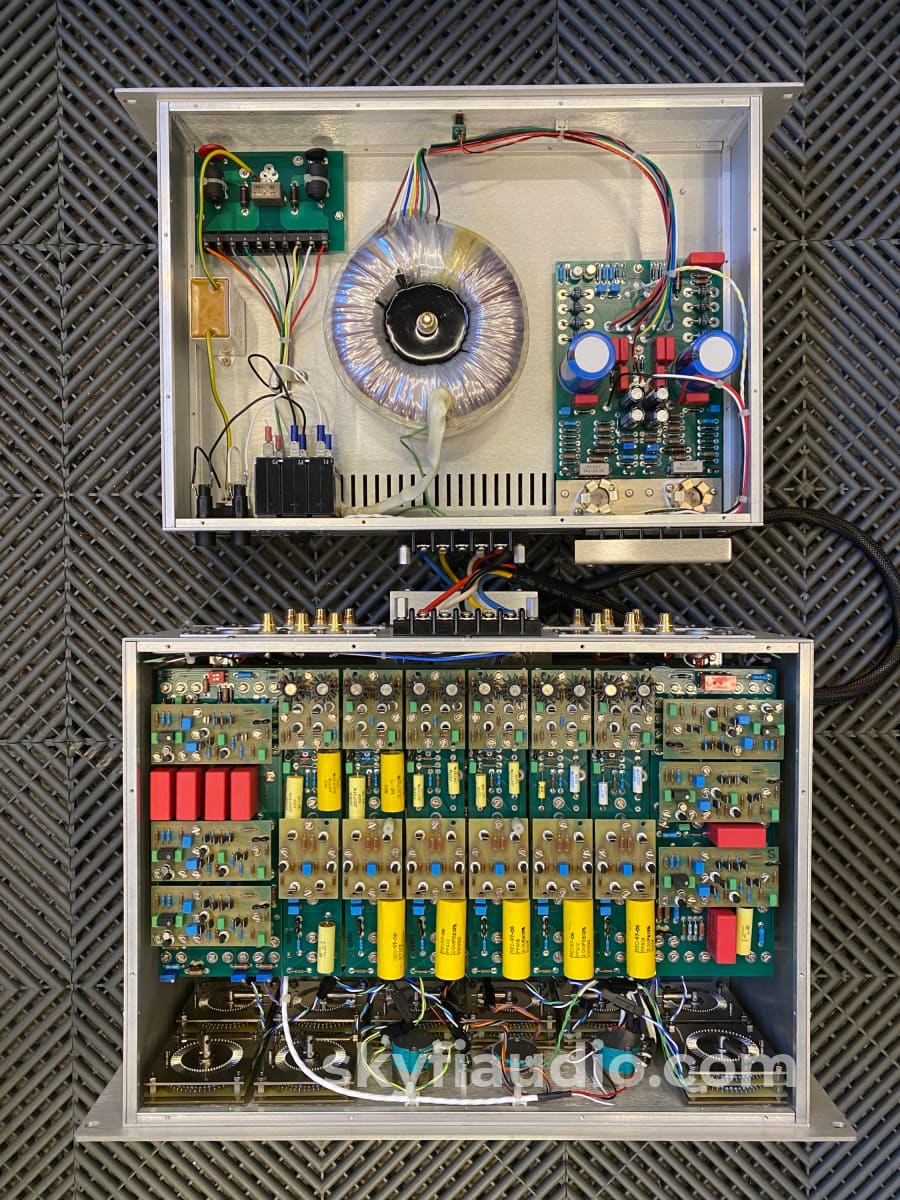
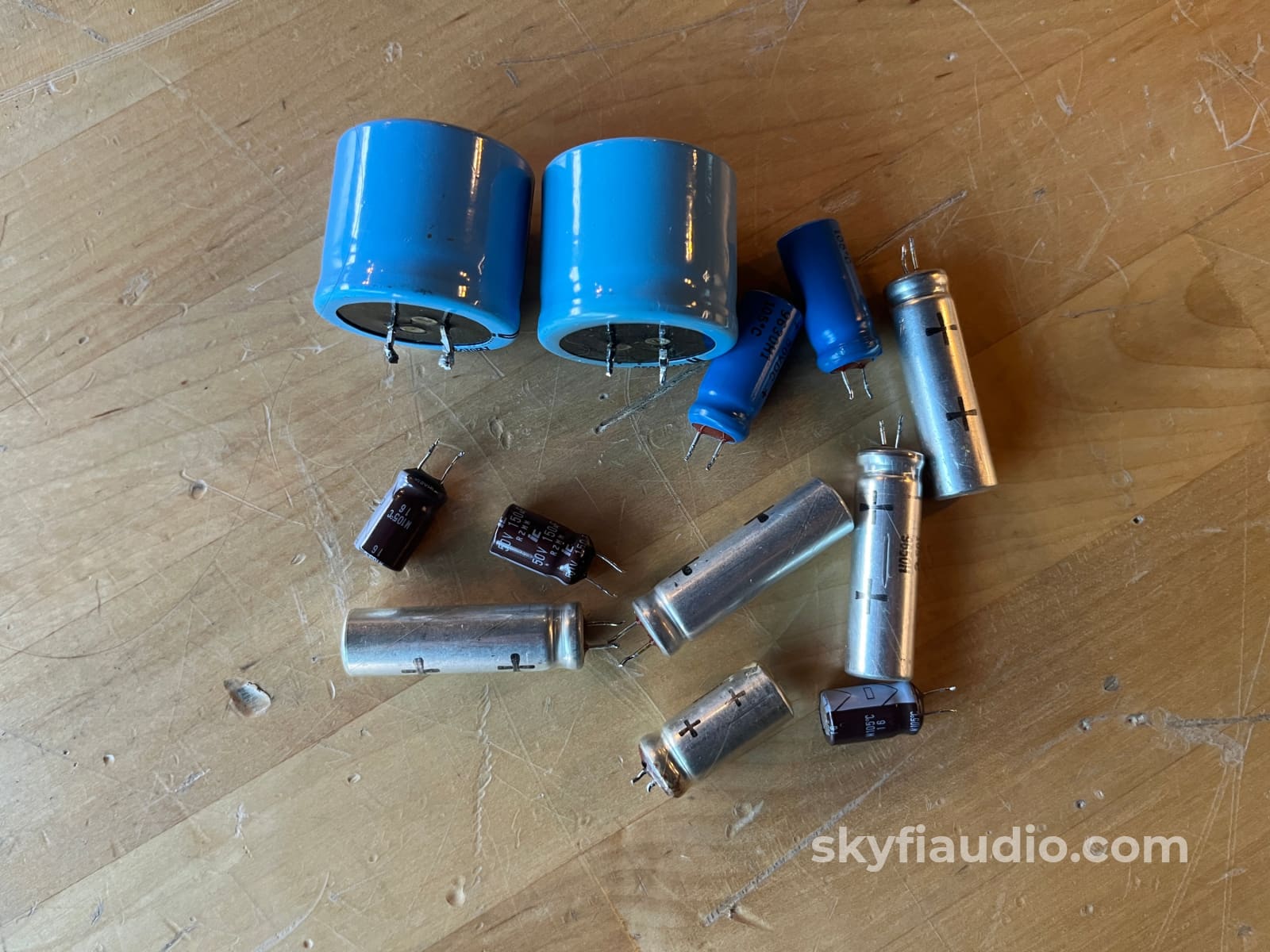
Cello Audio Palette EQ Preamp With Power Supply - Serviced
Free Shipping on Most Electronics - Excludes Speakers and Items Requiring Freight - Contiguous U.S. Only
Pickup currently unavailable at SkyFi 479

Cello Audio Palette EQ Preamp With Power Supply - Serviced
SkyFi 479
479 South Broad Street
Glen Rock NJ 07452
United States
General:
The Cello Audio Palette is arguably the highest quality equalizer ever made, and is somewhat rare.
This model is even rarer, as it can also be used as a preamp since it has an input selector. Notice the input selector knob on the top row, second from the right. Perfect if you don't use a turntable, or already have a high-quality phono stage.
Best of all this unit is additionally fitted with standard RCA connectors, not the less common Fischer type connectors usually found. There is a single pair of Fisher inputs and outputs in case you intend to use it with other Cello gear giving you ultimate flexibility. No problem if you intend to use this as a stand along EQ, you just ignore the input selector.
The Palette comes with a dedicated power supply which helps keep the noise floor as low as possible. There's also a beefy large gauge umbilical cord that connects the two units.
If you're going to use this as an EQ, it was intended that you keep the unit near your couch in a purpose built acrylic stand which we can offer as an optional add-on.
This piece was serviced by replacing the capacitors in the power supply and a few other critical places (see pics) and is working just like the day it was made.
Condition is superb with no significant scratches or damage anywhere.
Includes the umbilical cable connecting the two units and the power cable.
Cello Mini XLR cables also available for purchase if needed.
More from Cello:
Richard S. Burwen developed the concept for the Audio Palette. Burwen found that certain tone control adjustments were necessary to obtain the most natural, lifelike sound from recordings.
Cello has identified the major cause of sonic problems in recordings as the tonal balance that has been adjusted by the recording and mastering engineers in the studio. Each engineer uses a monitoring system that is unique. Because the tonal balance of each system is different, each recording is different. Engineers primarily use equalization to optimize tonal balance for the best sound on their system.
The Audio Palette advances musical realism more than any other single component. Tonal balance can be corrected from the most delicate and subtle adjustments for the best recordings, to the most extreme and dramatic adjustments for vintage material, in order to restore the vitality and life to recordings of music without sonic deterioration.
The Audio Palette is used by record companies, mastering laboratories, and also by discriminating home listeners.
SkyFi Cosmetic Notes:
The faceplate of both the Audio Palette and Master Supply show very light wear. The top of the Master Supply chassis has some scratch marks.
SkyFi Technical Notes:
This piece was serviced in house here at SkyFi. We replaced all of the electrolytic capacitors on the power supply board in the Audio Palette and replaced four known to fail capacitors in the Master Supply. All controls were cleaned and verified for proper operation. We also tested the balanced inputs and outputs.
Ownership:
Single Owner
Connections:
The Multiple Input Version (M.I.V.) Audio Palette has a total of four (4) inputs, one (1) Fischer 3-pin balanced and three (3) single ended.
One (1) set of single ended and one (1) set of Fischer 3-pin balanced main outputs are provided.
Two (2) sets of single ended record outputs are provided.
General Sound:
Smooth, uncolored, undistorted natural and clean
Cosmetic Condition:
8/10 = Very Good. Excellent front faceplate, one minor flaw on chassis side or top. See our detailed rating description here.
Working Condition:
Working perfectly and tested in our lab and listening room.
Included:
Just the unit and cable
Packing:
Will be packed using our highly developed in-house process and custom packing materials.Reviews:
Click Here
Specs:
Frequency Adjustment Controls:
25 kHz control: +/- 24 dB in 1.00 dB increments
5 kHz control: +/- 12 dB in 0.50 dB increments
2 kHz control: +/- 6 dB in 0.25 dB increments
500 Hz control: +/- 6 dB in 0.25 dB increments
120 Hz control: +/- 14.5 dB in 0.50 dB increments
15 Hz control: +/- 29 dB in 1.00 dB increments
Dimensions:
19"w / 7.4"h / 14.1"d (Audio Palette)
19"w / 3.9"h / 8.5"d (Master Supply)
Weight:
86 lbs.
Approximate Age:
1990
Link to Manual:
Click Here
Recommended Cables:
Kimber Kable - RCA Interconnects - Better
Kimber Kable - RCA Interconnects - Best
Kimber Kable - Power Cords - Better
Kimber Kable - Power Cords - Best
Testing Process:
We start with a visual inspection of all internal components to make sure that there are no signs of heat stress or damage. Capacitors are checked for telltale signs of predictive failure including bulging, shrunken wrappers, or physical leakage. We also inspect the PCBs for discoloration from resistors or transistors that may have been running hot. On vintage units we often spot check select capacitors for value and ESR.
When we first power on a preamplifier we connect its RCA output to a Sencore PA81 Power Analyzer which simulates real world loading conditions and gives us an oscilloscope interface.
The first order of business is checking that the volume control works smoothly throughout its entire range with acceptable channel balance. This is accomplished by feeding a 1 KHz sine wave into one of the preamp’s line level inputs while monitoring the preamp’s output on an oscilloscope.
We then switch to a 1 KHz square wave to test the tone controls, loudness function, and filters where applicable. During this step we are watching for equal alteration of the test signal by both channels. This also helps us identify dirty controls that will need treatment.
Once the basic line stage functions are verified, we test each input individually. This is especially important for devices that use relays to select their sources. If the preamp is equipped with a phono stage we test that as well. We use an inverse RIAA filter which allows us to feed a reference test signal into the phono input with the proper RIAA equalization and level. A square wave or sine sweep is used to verify that the device’s phono stage is faithfully reproducing the RIAA curve. If the preamp under test has balanced inputs and/or outputs these are tested as well.
We finish up our bench testing with a listening test with our bench amplifier and reference speakers. During this test we check for hum or hiss that may not have shown up in earlier testing. We also check that all of the tone controls and filters perform as expected.
If the preamplifier has remote control functions these are also tested. Preamps with tube circuits or complicated power supply topologies are connected at our long term test rig for extended stress testing under real world conditions.
Choose options




















